
LEAD Group XXIX International Study/Travel Seminar
Costa Rica
Saturday, January 15
Today we crossed the border from Nicaragua to Costa Rica. We were lucky to have people with many connections to help us cross the border. We were told the process could take up to 5 hours - we made it through in one hour 15 minutes. All we could say is thank goodness for wheels on suitcases. We had to cross the border on foot carrying our luggage for a long ways. The experience was incredible.
We are now in the city of Liberia waiting supper with the locals. We will experience a BBQ this evening and get entertained with cultural dancers. Our Internet connection this evening is slow, so we will not be posting pictures. I wish we could post sound clips - we are listening to the call of the monkeys as we work on this report. In the words of the Costa Rican people "Pura Vida" - Living life!!!
Sunday, January 16
Today we traveled to Arenal from Liberia. Along the way we saw a scenic view of Costa Rica and were able to witness the dry and then the tropical rain forests. We crossed the Continental Divide as we rounded Lake Arenal. We were able to see a hydroelectric plant that pipes the water to the Pacific "dry" side to irrigate the crops. One of Costa Rica's main industry is eco-tourism and we were able to experience this first hand through the places we have stayed thus far and the places we have stopped at along the way.
Some cool findings today were howler monkeys, toucans and the many sights of tropical plants, trees and birds. The severely winding roads through the rain forest were challenging, but we all survived .... barely!!!
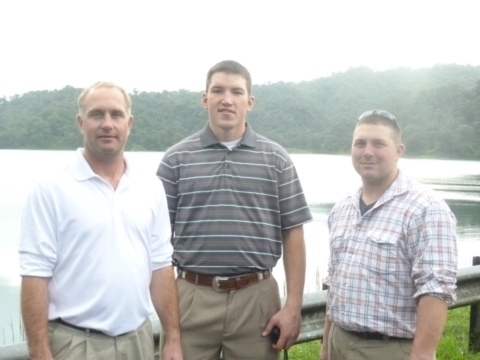 |
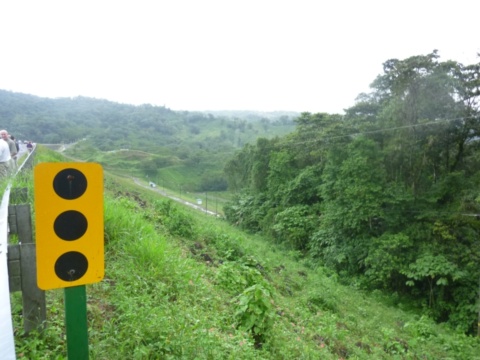 |
|
| LEAD Fellows looking at the dam on Lake Arenal | View of the tropical rain forest | |
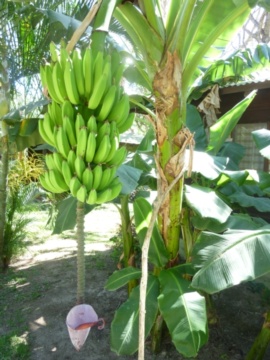 |
 |
|
| Banana tree | Howler monkeys | |
Monday, January 17
Buenos Dias! We did a lot of traveling today and were able to see many of the native crops of the area including tapioca, pineapple, sugar cane, rice, papaya and mangoes. The highlights of the day were stopping at a pineapple processing plant, a large dairy and an iguana viewing point. The day ended with a fiesta with our host families where we ate our traditional rice and beans and learned to salsa to spanish music. We also left a little Nebraska flavor by teaching the country swing and two-step.
The home stays were very interesting. Many of our host families did not speak any english. It was amazing how we all communicated using our hands and expressions. It was awesome to experience firsthand how a Costa Rican family lives. Their lifestyles are very similar, but their homes are built and equipped for the climate such as; no screens on the windows, no air conditioning, large open patios, walls that don't go up to the ceilings and outdoor kitchens just to name a few. Many of us do miss hot water, but cold water does wake you up quickly in the morning.
We find it unusual how they think 75 degrees is cold. We opened the windows to sleep since it was so hot and our host family commented in the morning how cold they were and didn't know how we could sleep. They had to get more blankets out and put coats on in the morning. We experienced bittersweet good-byes as we parted our host family's houses to board the bus on our way to San Jose.
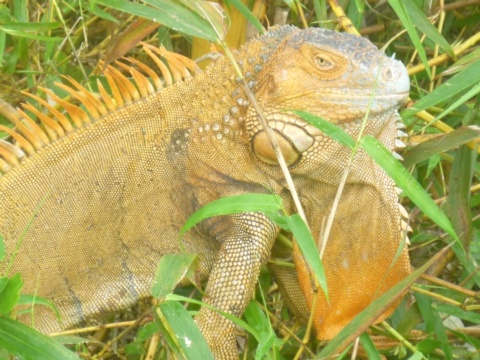 |
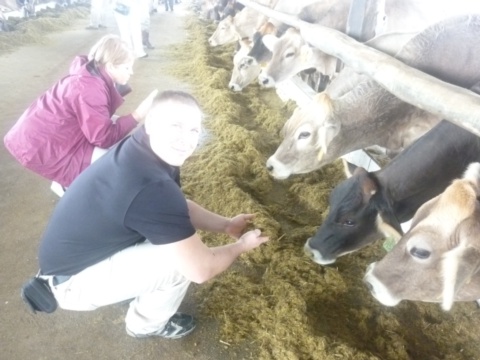 |
|
| Iguana at viewing point | Sara & Andy checking feed at the dairy | |
 |
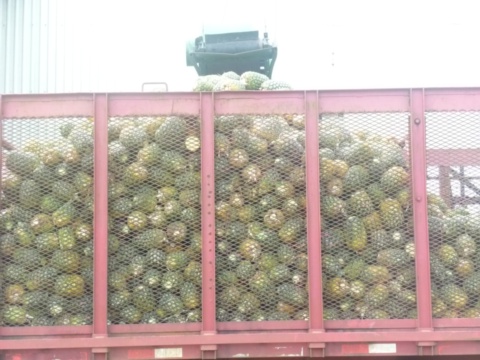 |
|
| Pineapple processing plant | "Defective" pineapples to be processed into cattle feed | |
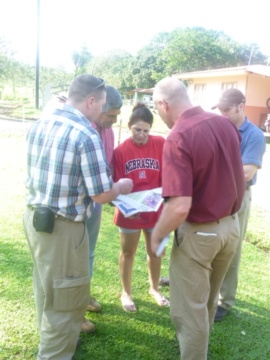 |
||
| Communicating with host family via maps & hand signals | ||
Tuesday, January 18
We traveled up and around the winding mountainous roads. It was extremely scary looking out the bus window and not even being able to see the bottom of the ravines. One inch closer to the edge would not have been a good situation. Several LEAD Fellows had to move to the front of the bus to avoid getting sick. Once we made it up the "treacherous" mountain it was worth the drive. The views were breath taking. It was cool to see ornamental houseplants growing in fields as a crop, the coffee plantations and witnessing how they raise cattle on such a steep terrain.
We made several stops today. Our first was at a local dairy processing cooperative that has 1,600 members that processes about 65% of the milk produced in Costa Rica. They also have their own feed mill that we got to tour. It was cool to hear the employees talking about the excellent quality imports of Dried Distiller Grains with Solubles (DDGS) they get from the U.S. We then stopped at an ornamental wood factory where they process local woods into beautiful crafts, beads, jewelry, etc. A topiary garden was another stop where we saw hand carved topiaries that were amazing!
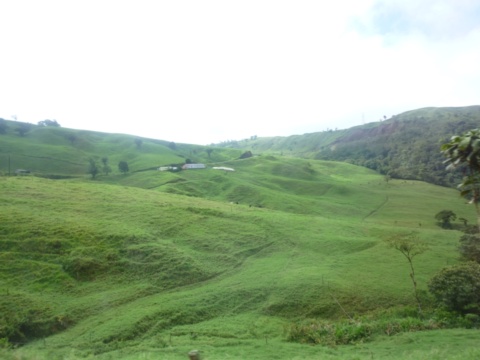 |
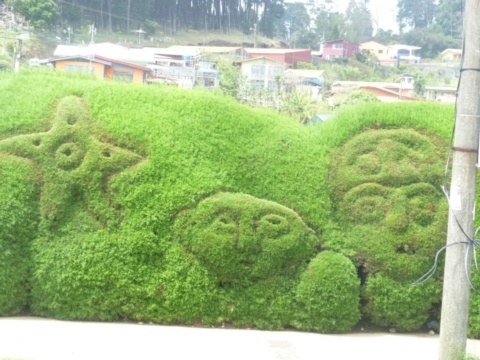 |
|
| View of mountain looking up to the coffee growing altitude | Topiary garden | |
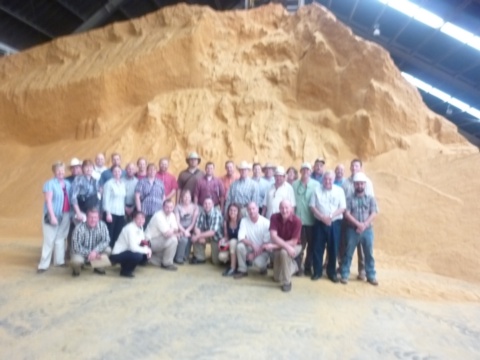 |
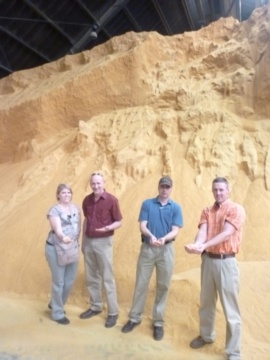 |
|
| LEAD Fellows in front of DDGS | At dairy cooperative feed mill examining the DDGS | |
Wednesday, January 19
Que pasa! Today we started out visiting the Inter-American Institute for Cooperation on Agriculture (IICA) and met with Dr. Amy Boren, the international liaison for IANR. We also met with Karen Lenzy, the Deputy Director General of IICA who previously worked in Washington with CAFTA and helped draft NAFTA. Dr. Boren made arrangements for us to visit a working didactic farm. It was interesting learning about the feed rations of the dairy cattle. The ration was comprised of barley, onions, bananas and mulberry trees. The farm also collects all fecal matter from the cattle and uses vermi-culture to process it into a sellable fertilizer. Vermi-culture is the use of red worms to digest waste, leaving behind castings creating a highly fertile compost. For the farm, the fertilizer generates more revenue than the milk.
We then traveled to a coffee cooperative where we saw a coffee plantation and processing plant. We learned red berries are easier to process than the green ones and that you can't mix them during processing. A few of us tasted the red berry directly from the plant and were surprised that it had no taste of coffee, rather it has a sweet taste.
Agromec, a New Holland dealership, was our next stop, where they hosted us for lunch. We toured the dealership and learned the different markets they manage such as equipment rental, sales, repairs and parts.
Our day ended with a tour of Datascension, a call center that handles the business of many United States Companies including Bayer, Experian, Intel, HP and many more. We were lucky to meet with the General Manager who is a Nebraska native and a personal friend of Mark Stock LEAD XXIX. He challenged us to work with our local economic development groups to organize a workforce in Nebraska rural towns, so that we can compete with the foreign work force market.
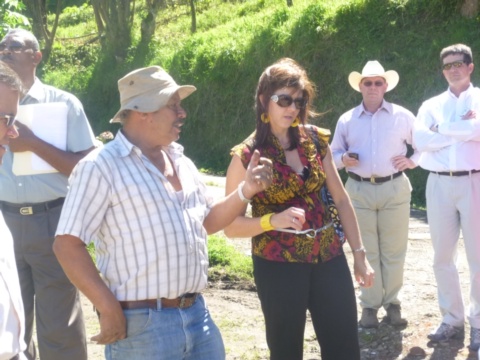 |
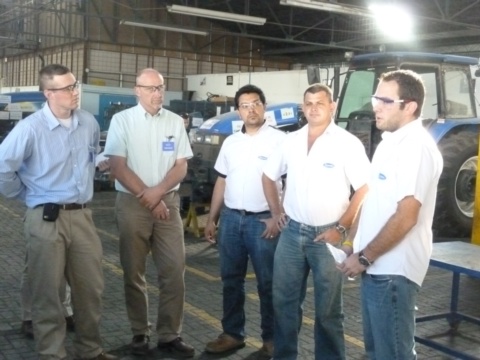 |
|
| Dr, Boren & didactic farmer explaining farm practices | Cody W & Ron S ask questions of Agromec Staff | |
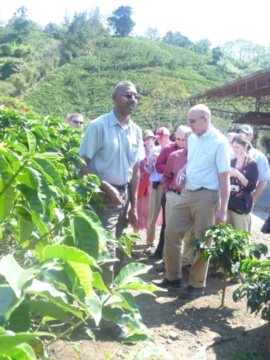 |
||
| Touring a coffee cooperative field | ||
Thursday, January 20
Our day started at the United States Embassy in San Jose, Costa Rica. We learned about Costa Rican agriculture during a presentation by the Attache for the Foreign Ag Services. Also meeting us at the Embassy were representatives from the American Soybean Association. After their informative presentations, we started on a six hour journey to Panama.
The group made a quick stop on the Tarcoles River where there is a large population of crocodiles. From the viewing bridge we were able to see many large crocodiles basking in the sun. It was amazing to be that close to crocodiles. They are truly prehistoric looking animals.
Along the Pan-American Highway we also witnessed breath taking views of the Pacific Ocean. It was magical seeing the fields of African Palm Trees with the view of the ocean behind them. African Palm kernels are harvested and processed into palm oil used for animal feed. By-products of that process are used for many cosmetics and bio-diesel.
Finally we arrived the Panama border. The border crossing was a very interesting process to say the least. Due to a new law that was past the day before, our tour guide and bus driver could not cross the border with us. Border Patrol would not let a bus of thirty people cross the border with only two returning. So, after having all our luggage searched piece by piece, we had to split into two groups of 15 and board two separate busses. It was amazing that only an hour later, we all ended up at the same hotel!
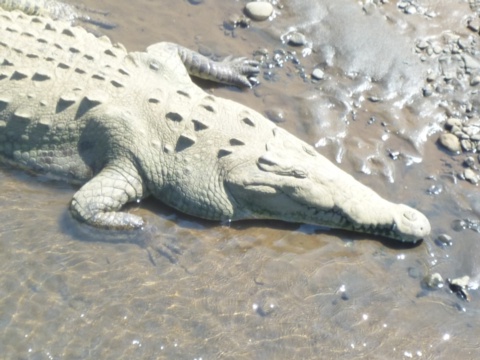 |
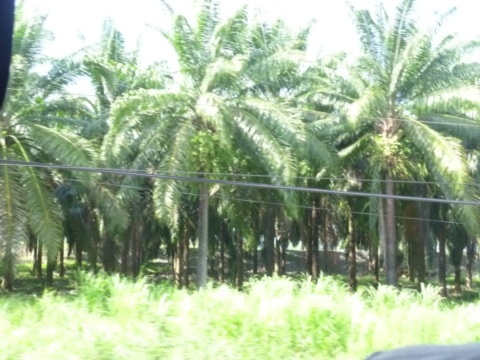 |
|
| Crocodile on the Tarcoles River | View from bus of an African Palm Tree Field | |
 |
||
| Going through customs at the border | ||